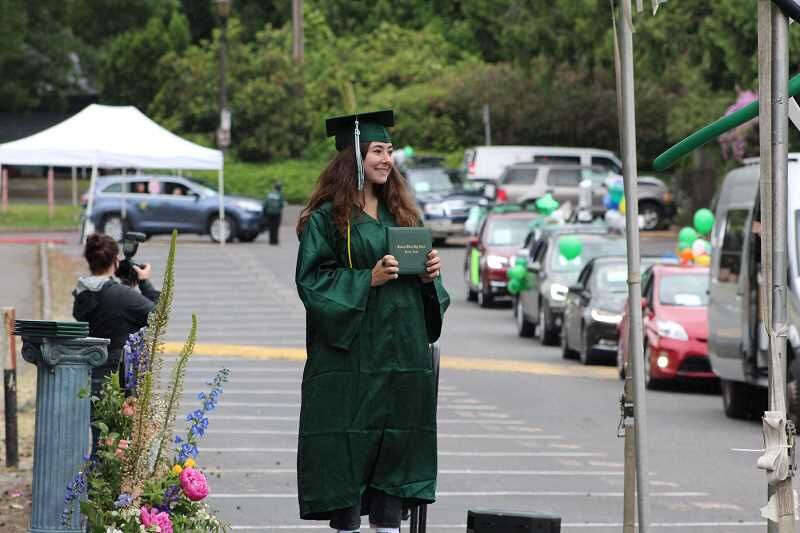Portland schools report higher graduation rates despite pandemic
Published 12:00 am Thursday, January 21, 2021

- A Wilson High School graduate poses for a photo during a drive-thru graduation ceremony in 2020. Most Portland High Schools showed an uptick in on-time graduation rates during the 2019-20 academic year, on par with a statewide steady increase.
Oregon education officials are celebrating an increase in the overall on-time graduation rate during the 2019-20 academic year.
Trending
Across Oregon, the graduation rate climbed from 80% in 2019 to 83% in 2020.
In Portland Public Schools, the graduation rate jumped to nearly 84%, up from 80.5% the year prior, making it the highest rate for PPS in the last decade.
Within Oregon’s largest district, nearly all student groups showed a jump in on-time graduation rates. Rates for Latino students jumped by four percentage points, while Black students saw a five-percentage-point increase in on-time graduations.
Trending
The uptick in on-time graduation rates was seen on a statewide level following an abrupt pivot to comprehensive distance learning in mid-March as the coronavirus pandemic hit Oregon.
Exceptions to the upward trend within PPS were Native students, who slid from an already low on-time graduation rate of 64% in 2018-19 to just 57% in 2019-20.
Asian and Pacific Islander students also saw a two-percentage-point decrease during the year when students shifted to distance learning. Native and Pacific Islander students make up a small fraction of students within PPS. Slides in on-time high school graduations were also seen among migrant students, who moved from a rate of 86% to 82%, according to the data.
Overall, graduation rates for PPS students of color exceeded 75%.
“We still have work to do, but we are pleased that the upward trend of students earning their degrees is continuing,” Guadalupe Guerrero, superintendent of Portland Public Schools, said in a statement released by the district Thursday, Jan. 21. “The 2019-20 numbers also serve as another indication that the investments we are making, the supports and counseling we are providing and our overall attention to students, are all paying dividends. Much of this work is made possible by funding streams including Measure 98 and the Student Investment Account, and all of our success is due to the immeasurable hard work by our educators, administrators, community-based partners and, especially, our students.”PPS has seen a 25-percentage-point increase in its overall graduation rates since 2009-10, when Oregon shifted to a stringent four-year model for measuring on-time graduation. Over the past three years, the district has seen a nearly six-percentage-point increase in its graduation rates.
Neighboring district David Douglas also saw a jump in on-time graduations. The east Portland district, which includes one high school, saw its student graduation rate climb from 79% in 2018-19 to 83.5% in 2019-20.
Four-year graduation rates increased for all of the district’s individual student groups.
That wasn’t the case in Portland’s Parkrose neighborhood.
Parkrose School District’s on-time graduation rate dipped five percentage points, to 76% compared with 81% in 2018-19.
Except for white students, students with disabilities and those in talented and gifted programs, the district saw a decline among almost all other student groups.
Black students at Parkrose showed a 15-percentage-point drop in on-time graduation, moving from 82% in 2018-19 to 67% last year. Hispanic and Latino students dropped 11 percentage points, to 69%, and underserved students dropped 13 percentage points across the district.
The district did not immediately respond to a request for comment Thursday.
State says unlikely correlation between lax rules and high grad rates
During a conference call with reporters Tuesday, Jan. 19, officials from the Oregon Department of Education said a statewide uptick in high school graduation rates came despite the pandemic’s impact on education, not because of it.
With the unexpected closure of schools last March, the state education agency advised school districts to allow students who were on track to graduate in March to receive diplomas, regardless of their academic performance during the rest of the year.
“The biggest impact likely was on the dropout rate,” Jon Wiens, director of accountability and reporting for ODE, said when asked about the impact relaxed credit guidelines had on high school seniors. “I don’t think (graduation rates) were affected nearly as much. If you think about some of the policies that were enacted, students that were passing classes in March were given credit. We don’t think that had a huge effect on graduation rates, because seniors had already made it three quarters of the way through their senior year. Those kids were almost surely on track to graduate anyway.”The state education agency celebrated the data showing a five-year steady increase in on-time graduation rates across Oregon, but acknowledged disparate outcomes for students of color and underserved students, compared with their white peers.
“On-time graduation rates have been steadily climbing since 2013-14 and are now more than 10 percentage points higher than six years ago,” Wiens said. “Obviously we’re very pleased at this, but as you’ll note, there are still graduation gaps, still work to be done.”
Within PPS, one high school leaned heavily into outreach and prevention efforts, while also trying to improve its school climate.
In Southwest Portland, Wilson High School, which is currently undergoing a name change process, saw its student grad rate jump, in line with district and state trends.
“When we transitioned to a digital learning environment, the three vice principals, in close collaboration with our teachers, kept a laser like focus on our students who were not engaging in online learning,” said Ayesha Coning, a 10th grade vice principal at the school. “The (vice principals), along with our school counselors, social worker and attendance coach, spoke with their parents and guardians, the students, made socially-distant home visits [and] delivered technology and textbooks.”
Coning also credits anti-racism work within the school to a more successful year for students.
Before schools closed last year, the high school partnered with the Anti-Defamation League and became a “No Place for Hate” school.
“We have a cohort of 20 11th and 12th graders who were trained by the ADL to facilitate anti-hate lessons, and specifically about how to be an ally, with their peers. This partnership was funded by our Measure 98 budget and in partnership with the ADL and the Portland chapter of the Jewish Federation,” Coning said.
Culturally specific clubs were also given a boost thanks to Measure 98 funds used to support affinity clubs and groups such as the Black Student Union, Muslim Student Association and Asian Desi Pacific Islander Student Union and the Latino Club.
“We believe that by supporting our historically underserved students in their efforts to share affinity space with each other that helps their ability to stay engaged in school and on track to graduation,” Coning said.
An anti-hate action plan with accompanying staff equity team was also assembled to help foster the professional development of teachers learning to teach historically underserved students.







